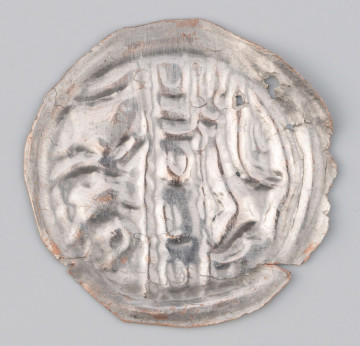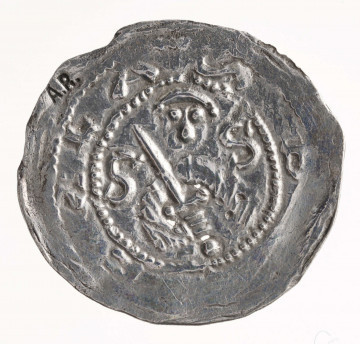
Bracteate of Mieszko III the Old
1181 — 1202
National Museum in Lublin
Part of the collection: Money on Polish territory in the Middle Ages
In 1173, Mieszko, the eldest of Bolesław the Wrymouthed's sons, succeeded to the Kraków throne in the Polish district. His political plans were aimed at centralising power in the country as it had been before the schism (1138). Mieszko's ambitions are indicated by his use of the title of supreme prince (Latin: dux maximus) and the aspirational formula King of Poland, recorded on Hebrew coins. The implementation of these intentions led to the subduing of the magnates' independence, and strict supervision over the sources of income of the state. The wealth of the princely treasury was to be increased by reformed minting, based exclusively on one-sided denars made on very thin sheet, called brakteates. The brakteate technology multiplied the efficiency of numerous princely mints covering the demand for multiple compulsory exchange of coins. The exchange was carried out according to a calculation favourable for the issuer and although a burden for the subjects, it supplied the princely treasury. The strong-arm policy increased the discontent of the magnates and district princes, who in 1177 deprived Mieszko of his power. Although until his death († 1202) Mieszko reached the throne in Kraków several more times, he did not manage to restore the prestige of the central power. From the last quarter of the 12th century, the competences ascribed to it, including the right to issue money, were taken over by the mighty and local princes. After losing his supreme power, Mieszko also became one, minting his coins in the Greater Poland region.
Several tens of types of brakteates are connected to his person. The chronology of many of them is unknown and it is not known whether they are the remains of the duke's senior or district reign. An interesting novelty introduced by this ruler was the issue of coins with Hebrew legends. This resulted from entrusting the mints to Jewish leaseholders, specialists in finance. The engravers of the stamps could be Hebrews. One of those coins is a brakteat with a frontal representation of a half-figure of a prince with a palm branch and a greeting in Hebrew ‘bracha’ (blessing) addressed to the ruler. It is associated with the palm realisation, which is most likely a wish for power, prosperity and victory of the ruler.
Tomasz Markiewicz
Author / creator
Dimensions
cały obiekt: diameter: 16,8 mm
Object type
numismatic
Technique
stamp minting
Material
silver
Creation time / dating
Creation / finding place
Owner
The National Museum in Lublin
Identification number
Location / status

1181 — 1202
National Museum in Lublin

1180 — 1199
National Museum in Lublin

1164 — 1170
National Museum in Lublin
DISCOVER this TOPIC
National Museum in Lublin
DISCOVER this PATH
Educational path